The second terrace on Moray Place, 11-17, was built soon after the first, circa 1862, and first occupied around 1864. The initial occupants at No 11 were the Mactear brothers, Andrew and William. The Mactears’ story features photography, chemistry, artificial diamonds, a famous auctioneer and a curious double death.
Rev James MacTear
Their father was James Mactear (though the family used variously MacTear, McTear, McTyre, etc), who was born in Ireland. He married Agnes (or Mary) Lachlan(e) in Glasgow on 13 June 1803, and had four boys, John in 1810, Andrew in 1817, Robert in 1821 and William in 1823 .
Sedition!
He may have been the James MacTear, a teacher of English and Mathematics in Calton, who was arrested in 1817 for swearing unlawful oaths. There was poverty and great dissent following the Napoleonic wars, and the extravagant behaviour of the Prince Regent (the future George IV) wasn’t helping either. The unrest eventually led to the Peterloo Massacre in Manchester.
MacTear was accused of being part of a secret society plotting to overthrow the government, as part of a crackdown on dissident groups who were seeking reform of society and parliament, even though their methods were often mere peaceful protest. In some cases, the reformists were actually being egged on by government spies as a form of entrapment. Alex Richmond’s published account of the episode is suspect as he himself was a government spy at the time . Others involved in such protests were convicted to transportation or hung, though James was never charged with anything . There are concerning parallels here with the current Public Order Bill working through Parliament (Nov 2022), though I might get arrested for saying so.
Protest eventually led to the Reform Act of 1830, and the granting of Glasgow’s first-ever MP.
Lithography
In 1841 Andrew, Robert & William were living in Great Hamilton Street (in the Barras, now London Road) with their father, who was now a collector of police rates – perhaps a poacher turned gamekeeper – although Andrew’s death certificate many years later recorded his father was also a clergyman. Andrew (24) & William (18) were already working as lithographers; Andrew had his business at 95 Argyll Street.
On 13 June 1844 Andrew married Martha De Courcy Lewthwaite, daughter of the late John Lewthwaite, Esq, Comptroller of HM Customs at Bo’ness, and in 1845 was living at 1 Monteith Row in Calton, only a few yards from their previous home but now overlooking Glasgow Green.

The Monteith Row tenements overlooked Glasgow Green but are long gone apart from one solitary block. In this 1916 photo the McLellan Arch can be seen on the right at the entrance to the Green. Erected here in 1892, it has since moved to the Saltmarket entrance. 1 Monteith Row is in the foreground. Source: Glasgow City Archives
Over the next five years they had a son James (b. 1845) who survived, and three daughters who did not. Susan died in 1847 at Cleland Testimonial, the building on the corner of Buchanan Street and Sauchiehall Street (ex TopShop), while Martha and Agnes died within two months of one another in autumn 1850, back at 22 Monteith Row. Although I don’t know the causes of death, cholera was rampant at the time. Martha likely also died young, as Andrew was to marry again in 1852.
Incidentally, Martha’s sister’s grand-daughter was De Courcy Lewthwaite Dewar, a member of the Glasgow Girls arts group, working and teaching at the Art School in enamel and metalwork art nouveau designs .
In the early 1850s Andrew was president of the Glasgow Heritable Property Investment Company, an early building society .
In 1851 he was at 22 Monteith Row with his son, and his sister-in-law (his wife Martha’s sister). PO Directory records the lithography firm now as A & W McTear, with William as a partner, and in 1852 the business moved to 2 St Enoch Square.
In 1852 Andrew married Janet Falconer (nee Latta), daughter of the late William Latta, a shipowner from Dumbarton. Janet had married Robert Falconer in 1838. He was 24 years her senior and already had seven children and lost two wives, but presumably Robert died soon after too. As far as I can tell, Janet never had any children of her own from either marriage.
1854 Andrew set up a scheme to collect bibles and other books for the Crimean troops in Scutari Hospital, Constantinople (Istanbul), in response to the same reports of terrible conditions that led Florence Nightingale to reform the hospital and create the foundations of modern nursing .
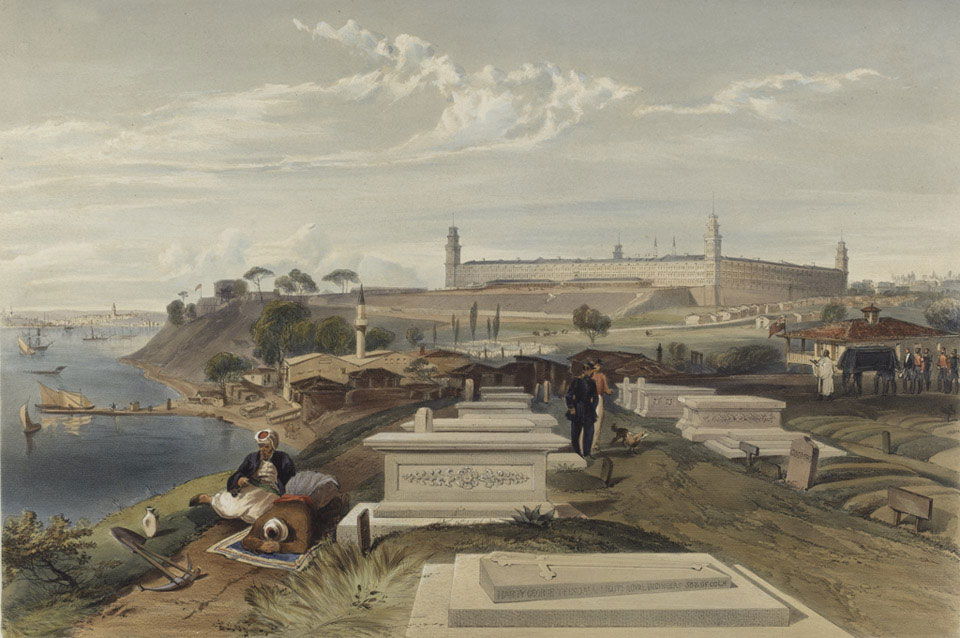
The temporary hospital in an army barracks, and the cemetery at Scutari. The mortality rate for those admitted from Crimea was over 40%. The barracks still exist today. Source: National Army Museum
By 1859 they had moved to 29 Apsley Place in the Gorbals, although the 1861 census found them and their servant temporarily living on the seafront in Dunoon, perhaps as a holiday. Andrew’s brother and business partner William, who had never married, had moved in with them at Apsley Place and was alone there on census night. The partners at that time employed 4 men and 3 boys.
Around 1864 the family (Andrew, Janet and son James) moved to the newly built house at Moray Place. William moved in with them, and there Andrew, Janet and William lived out their lives over the next 30 years.
The Lithography Business & Photography

Advert for A&W Mactear, Glasgow Courier 1853. Source: BNA
The main business was lithography, engraving, printing and stationery, but Andrew also had a clear interest in the developing field of photography, and not just in its uses in printing.
In 1859 he published an article in The Photographic News, “The Wet Versus the Dry Process” in which he described a trip he had taken into the Trossachs in order to test the merits of wet versus dry collodion for landscape photography . It was a travelogue that illustrated the balance photographers struck between demonstrating their technical skill and entertaining readers with a ‘cultivated’ sense of humour – rather than discuss the technical details, he wandered into quoting Walter Scott poetry, telling tales of “ladies of the lake” out promenading, and how his subjects couldn’t watch due to the need to stay still for the shot, and a lad selling “Highland nuts” to gullible tourists and being bribed not to step in front of the lens. His conclusion was that wet (on-site) processing was better, simply because he let his dry plates get ruined by the rain on the way home. Early on he even confesses to, as a child, using his younger brother’s hair to help plaster his house.

Andrew Mactear’s article in the Photographic News of March 1859 describing his trip to the Trossachs. Click to read the full article. Source: Google Books
In 1860 he presented a paper on The History of Photography in Glasgow to the City of Glasgow and West of Scotland Photographic Society, of which he was vice-president . The society foundered as the committee was considered too dictatorial, and Andrew led the disruption, and the formation of the successor Glasgow Photographic Association in 1862 .
He was also the vice-president of the new Association in its first year, and presented further talks on a summer photographic excursion and on photolithography . The University of Glasgow possesses an album that contains photographs of committee members and some of their works, which gives us the only known photograph of Andrew .

Andrew Mactear, Vice President of the Glasgow Photographic Association 1862-3. Source: University of Glasgow
However he subsequently appears to have stuck to the core business, and I have not found any surviving examples of his photographic work.
3rd Lanarkshire Rifle Volunteers
Andrew, Robert and William were all active members of the Third Lanarkshire Rifle Volunteers, as were many south-siders and Strathbungo residents of that time. Andrew was the ensign, and his brothers were both officers. He supervised a shooting match against a Paisley regiment, which of course the Strathbungo regiment won. They were present in Queen Victoria’s Volunteer Guard at the opening of the Loch Katrine waterworks in 1859, and at subsequent anniversary dinners in Glasgow. The Loch Katrine event was the first public appearance of the new Scottish volunteer force, the forerunner of the modern Territorial Army.
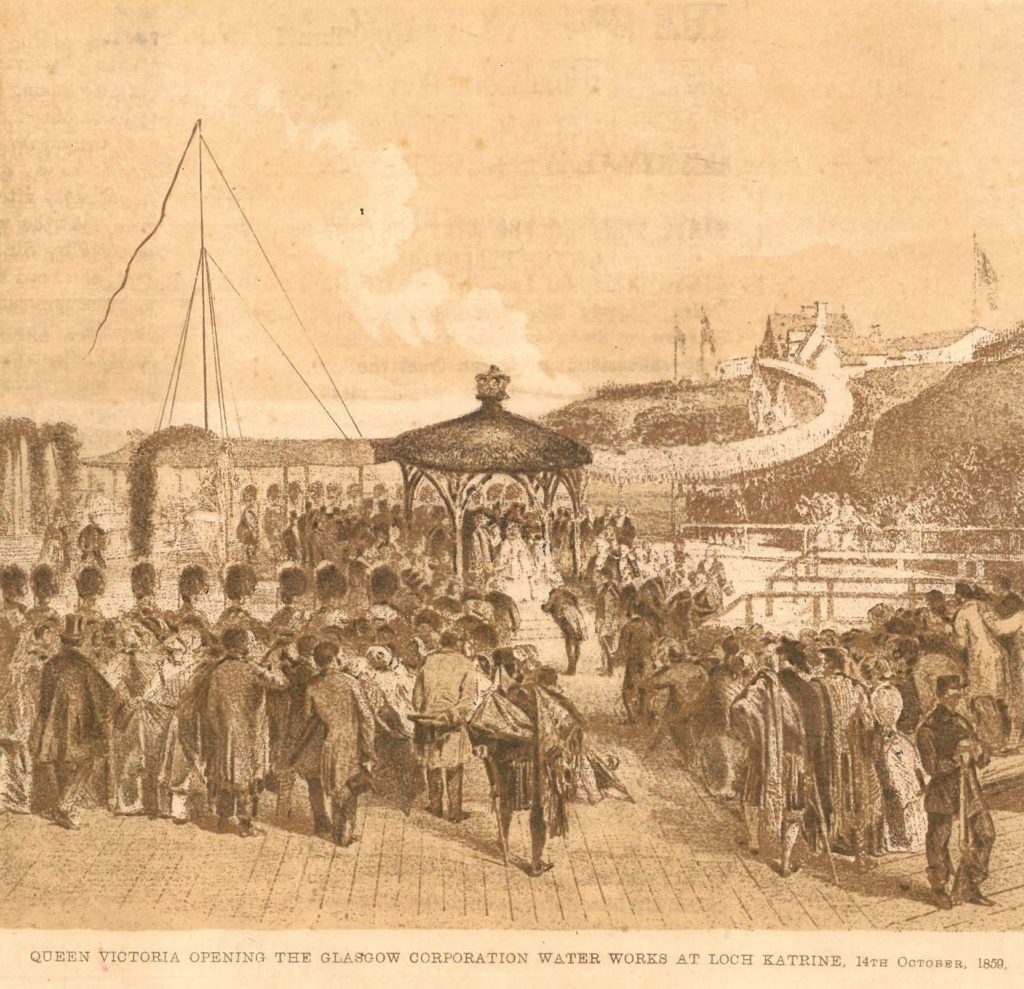
Queen Victoria opens the Loch Katrine waterworks, 1859. Source: Glasgow City Archives

Memorial Book for the Queen’s Volunteer Guard at Loch Katrine, 1859. Source: Abe Books
Death – A Singular Occurence
The brothers met a tragic end on 17 January 1896 at their home in Moray Place, described in the Perthshire Advertiser as “A Singular Occurence”, in the sense of being unusual . However it appeared less a conspiracy and more a case of brotherly devotion. Andrew died at 9am from “debility, old age and hypostatic pneumonia”, suggesting he had been frail and bedridden for some time. Four hours later his brother William died of apoplexy and convulsions, though his death certificate attributed this to a stroke he had suffered a few weeks earlier . The double death was likely no more than coincidence, or a suitable end to two lives lived together in both work and leisure.
The house and the printing business were both promptly placed up for sale by auction, and Andrew’s wife Janet moved to an apartment at 9 Regent Park Terrace on Pollokshaws Road where she died on 16 Feb 1900.
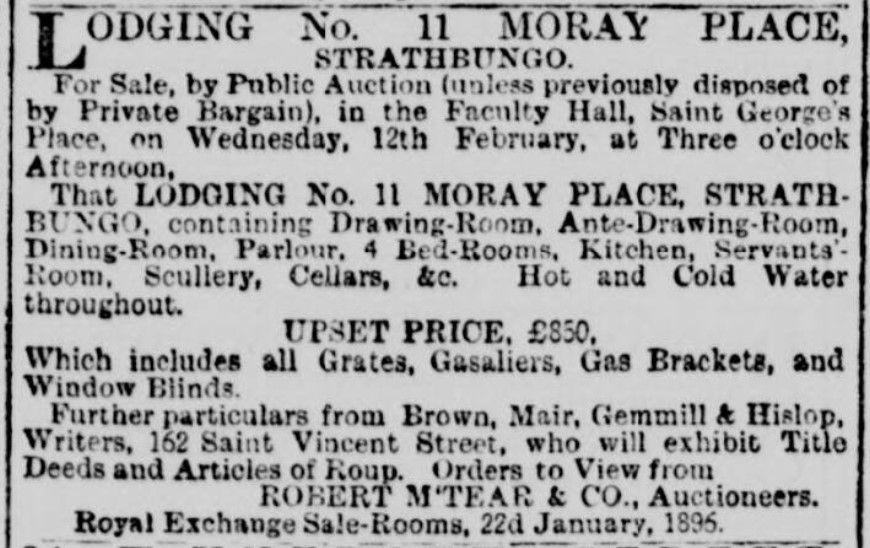
Advert for sale of 11 Moray Place. Glasgow Herald 22 Jan 1896. Source: BNA
Brother Robert McTear
Their brother Robert took a different path, and became an auctioneer. He worked initially for Barclay & Skirving in Trongate before forming McTear & Kempt in 1842 with his business partner Donald Kempt. McTear became the sole owner in 1863, and his firm McTear’s is still going strong in Glasgow 180 years later as one of the largest independent auction houses in the UK, a market leader in the sale of fine art, whisky and jewellery. In politics he was a a larger-than-life character, a famous champion of Liberal causes and a supporter and a friend of the Italian revolutionary, Garibaldi, famous for unifying Italy. He visited Garibaldi in 1869 to enrol him in the Irvine Burns Club!
In 1848 he was the editor of Glasgow Punch, a satrical periodical that was a forerunner of The Bailie. Away from the world of politics McTear was a treasurer of the Glasgow Musical Association. He helped acquire an organ for the City Halls and was responsible for bringing Charles Dickens to the city in the 1860s to give readings from his works . The story goes that once when Robert was talking with an actor friend, the subject turned to the popularity of Charles Dickens. Robert wrote to him and offered £600 to do 12 readings in Scotland. The performances created a storm. Police kept crowds back from the main doors and, inside City Hall, women fainted in the aisles and cried over the saddest parts of his stories .
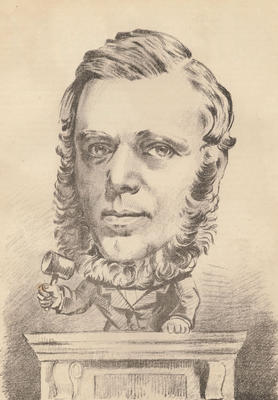
Robert McTear, auctioneer, as portrayed in The Bailie. Source: Mitchell Library
Son James Mactear
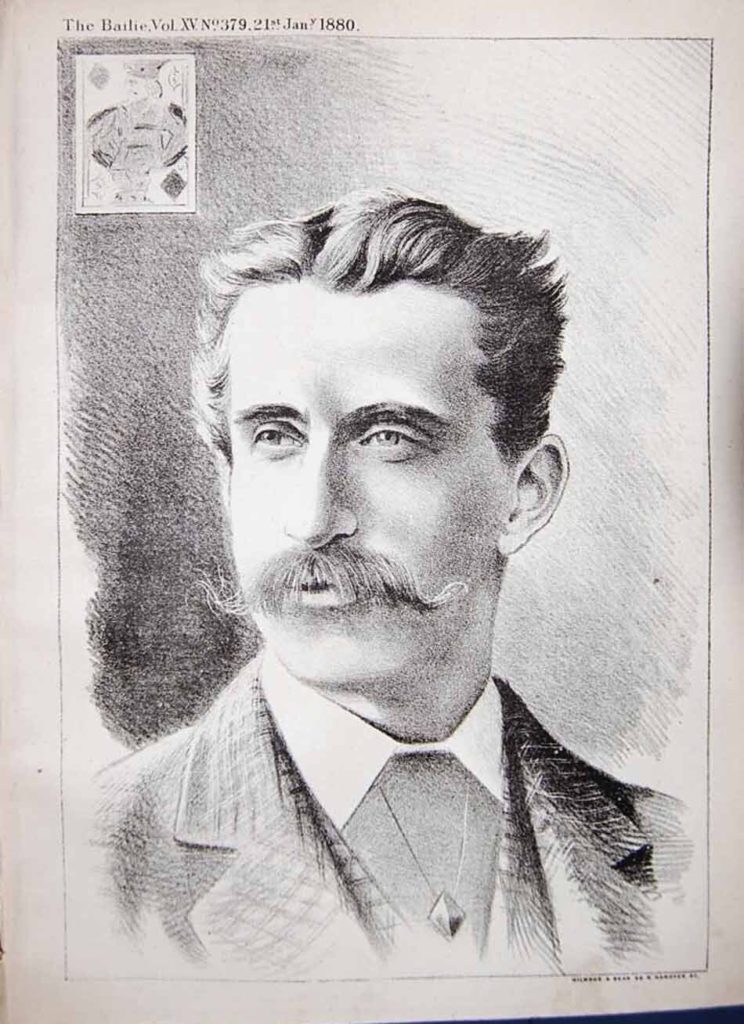
James Mactear, as depicted in The Bailie, 1880. Source: eBay
Andrew’s son James also became a person of note in his own right. While a child he “had a narrow escape from being apprenticed to the trade of engraving”, but instead studied chemistry under Dr Wallace, later the city analyst (incidentally the one who investigated the adulterated butter made by another Moray Place resident). He worked briefly with Edmund Stanford, who pioneered iodine extraction from seaweed, then for three years as a manager at a chemical works in Newcastle, before returning in 1867 to become manager at Charles Tennant’s St Rollox works, the largest chemical factory in the world. He was so successful that within two years he was made a partner in the business, responsible for all technical aspects.
In 1880 he declared his research had been rewarded with the creation of artifical diamonds, which caused great excitement in the local press, and resulted in a “Men You Know” article in The Bailie, along with the above caricature. However a few weeks later he announced that he was mistaken in his conclusions.
After 17 years at Tennants he retired and moved to London to work as a consulting engineer, working for the Witwatersrand Chamber of Mines in South Africa (and discovering gold in Persia) among other projects. He was interested in gold extraction, some co-incidence given that the father of Dr Forrest of 1 Moray Place helped develop the standard MacArthur-Forrest process for gold extraction. He also became an expert in quicksilver (mercury) extraction. Amongst other awards, James was inducted into the Institution of Civil Engineers in 1897.
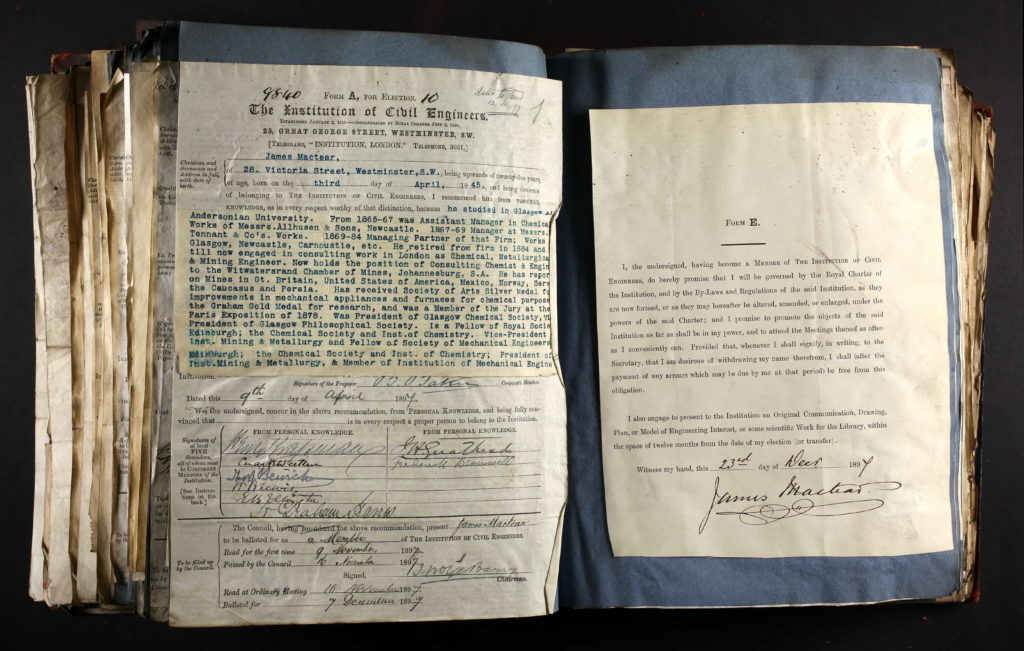
James Mactear’s application to the Institute of Civil Engineers, founded by Thomas Telford. Source: Ancestry.com
Like his father and uncles, he was active in the Lanarkshire Rifle Volunteers.
He died at his residence in London on 3rd June 1903, at the age of fifty-eight.
James Lindsay
The house was sold by Robert McTear auctioneers (see the advert earlier), and taken up by James Lindsay, an established architect, and his family.
James was born in Glasgow in 1857, the son of William Lindsay, a victualler and his wife Mary Duncan . He was educated at St James Parish School and Glasgow High School, and articled to Peat & Duncan, c.1872-77, remaining with them for a further three years as draughtsman during which time he studied at Glasgow School of Art and won the RIBA Silver Medal in 1876. In 1880 he set up practice on his own account at 196 St Vincent Street and immediately came into some prominence by submitting a very accomplished Beaux-Arts design in the Glasgow Municipal Buildings competition which was published in the ‘British Architect’ on 20 October 1882 and reflected his friendship with James Sellars. He was admitted ARIBA on 3 January 1881, his proposers being John Honeyman, William James Audsley and John Burnet.

James Lindsay’s entry for Glasgow’s Municipal Buildings (the City Chambers, George Square). Source: The Mitchell Library
On 25 September 1883 Lindsay married Jessie Millar Black at 48 Caledonia Street, Paisley. In that year or the following one Lindsay formed a short-lived partnership with Malcolm Stark, perhaps only for the purpose of entering the New Admiralty and War Office competition, but this was quickly dissolved if ever formalised. Like Stark, Lindsay came near in national competitions without ever actually winning. Stark later partnered with another Strathbungo architect, Fred Rowntree. Although James was one of the most accomplished designers of his generation his clients were primarily industrial and his architecture is often a reflection of the disappointments of his career.
Examples of his work include the villa Ardenvohr, in a prominent position at 233 Nithsdale Road, on the corner of Albert Drive, and the City Manure Office in Townhead and the Glasgow Sausage Works for R D Waddell on North Woodside Road, the latter now demolished.

James Linday’s Glasgow Sausage Works, North Woodside Road at Napiershall Street, 1967. Source: John Hume/Canmore
Lindsay and his wife had six children between 1885 and 1894. They moved to 11 Moray Place in 1896, but Jessie died only two years later, leaving James to bring up the children. He died of renal cancer at 11 Moray Place on 8 September 1914 . He bequeathed the painting Head of the Holy Loch by George Henry to Glasgow. Henry was one of the most influential of the ‘Glasgow Boys’ artists based in or associated with Glasgow. The painting dated 1882 is usually on display in Kelvingrove Art Gallery and Museum .
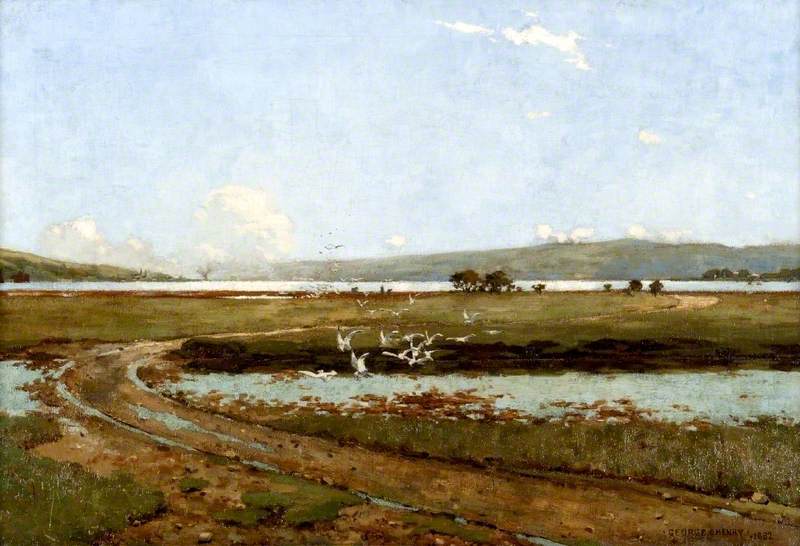
Head of the Holy Loch by George Henry. Source: Glasgow Museums
His son James Lindsay Junior then took over the practice at the early age of twenty-two, initially in collaboration with Robert Leslie Rollo, and built mainly domestic buildings including a number of bungalows in the north-west of Glasgow . His best known building may be Walter Hubbard’s art deco bakery on Great Western Road, better known to those of a certain age as Clatty Pats nightclub (aka Viper, Brewhouse/Bakehouse, Kitty O’Sheas) .
Between 1915 and 1925 the number of children living at Moray Place dwindled from five to four to three, with James, Lizzie and Jessie still present in 1925. James was still there in 1930, but was at 28 Springhill Gardens by 1938.
The last occupant on record was Dr J M Young c 1938-1942, but I have no further details about them.
Additions and corrections welcome, as always.
References
{3557955:IGYQFCAH};{3557955:GKDRT8HL};{3557955:MGE9EBH9},{3557955:ZMCCHIIW},{3557955:RZPJN2SI};{3557955:4BRWZ32H};{3557955:HT4ZE48B};{3557955:TJ3B62B2};{3557955:A3Z52DN6},{3557955:4T8LJGGE};{3557955:4T8LJGGE};{3557955:4T8LJGGE};{3557955:4T8LJGGE};{3557955:ZU9WUP92},{3557955:V2FXK7SA};{3557955:4T8LJGGE};{3557955:4T8LJGGE};{3557955:4T8LJGGE};{3557955:4T8LJGGE};{3557955:Q5BJDT6V};{3557955:RZCJ7ZMV};{3557955:RZCJ7ZMV};{3557955:VXZ4BVM2};{3557955:RZCJ7ZMV}
vancouver
asc
0
3857
%7B%22status%22%3A%22success%22%2C%22updateneeded%22%3Afalse%2C%22instance%22%3A%22zotpress-bdb6697a694e83cf40b111aea243b879%22%2C%22meta%22%3A%7B%22request_last%22%3A0%2C%22request_next%22%3A0%2C%22used_cache%22%3Atrue%7D%2C%22data%22%3A%5B%7B%22key%22%3A%22A3Z52DN6%22%2C%22library%22%3A%7B%22id%22%3A3557955%7D%2C%22meta%22%3A%7B%22creatorSummary%22%3A%22Mactear%22%2C%22parsedDate%22%3A%221859-03-11%22%2C%22numChildren%22%3A0%7D%2C%22bib%22%3A%22%3Cdiv%20class%3D%5C%22csl-bib-body%5C%22%20style%3D%5C%22line-height%3A%201.35%3B%20%5C%22%3E%5Cn%20%20%3Cdiv%20class%3D%5C%22csl-entry%5C%22%20style%3D%5C%22clear%3A%20left%3B%20%5C%22%3E%5Cn%20%20%20%20%3Cdiv%20class%3D%5C%22csl-left-margin%5C%22%20style%3D%5C%22float%3A%20left%3B%20padding-right%3A%200.5em%3B%20text-align%3A%20right%3B%20width%3A%201em%3B%5C%22%3E1.%3C%5C%2Fdiv%3E%3Cdiv%20class%3D%5C%22csl-right-inline%5C%22%20style%3D%5C%22margin%3A%200%20.4em%200%201.5em%3B%5C%22%3EMactear%20A.%20The%20Wet%20versus%20The%20Dry%20Process.%20The%20Photographic%20News%20%5BInternet%5D.%201859%20Mar%2011%3B9%26%23x2013%3B10.%20Available%20from%3A%20%3Ca%20href%3D%27https%3A%5C%2F%5C%2Fwww.google.co.uk%5C%2Fbooks%5C%2Fedition%5C%2FThe_Photographic_News%5C%2FnbQaAAAAYAAJ%3Fhl%3Den%26gbpv%3D0%27%3Ehttps%3A%5C%2F%5C%2Fwww.google.co.uk%5C%2Fbooks%5C%2Fedition%5C%2FThe_Photographic_News%5C%2FnbQaAAAAYAAJ%3Fhl%3Den%26gbpv%3D0%3C%5C%2Fa%3E%3C%5C%2Fdiv%3E%5Cn%20%20%3C%5C%2Fdiv%3E%5Cn%3C%5C%2Fdiv%3E%22%2C%22data%22%3A%7B%22itemType%22%3A%22journalArticle%22%2C%22title%22%3A%22The%20Wet%20versus%20The%20Dry%20Process%22%2C%22creators%22%3A%5B%7B%22creatorType%22%3A%22author%22%2C%22firstName%22%3A%22Andrew%22%2C%22lastName%22%3A%22Mactear%22%7D%5D%2C%22abstractNote%22%3A%22%22%2C%22date%22%3A%2211%20Mar%201859%22%2C%22language%22%3A%22%22%2C%22DOI%22%3A%22%22%2C%22ISSN%22%3A%22%22%2C%22url%22%3A%22https%3A%5C%2F%5C%2Fwww.google.co.uk%5C%2Fbooks%5C%2Fedition%5C%2FThe_Photographic_News%5C%2FnbQaAAAAYAAJ%3Fhl%3Den%26gbpv%3D0%22%2C%22collections%22%3A%5B%22CAR6MXPM%22%5D%2C%22dateModified%22%3A%222022-11-09T22%3A42%3A29Z%22%7D%7D%2C%7B%22key%22%3A%22RZCJ7ZMV%22%2C%22library%22%3A%7B%22id%22%3A3557955%7D%2C%22meta%22%3A%7B%22parsedDate%22%3A%222019-05-19%22%2C%22numChildren%22%3A1%7D%2C%22bib%22%3A%22%3Cdiv%20class%3D%5C%22csl-bib-body%5C%22%20style%3D%5C%22line-height%3A%201.35%3B%20%5C%22%3E%5Cn%20%20%3Cdiv%20class%3D%5C%22csl-entry%5C%22%20style%3D%5C%22clear%3A%20left%3B%20%5C%22%3E%5Cn%20%20%20%20%3Cdiv%20class%3D%5C%22csl-left-margin%5C%22%20style%3D%5C%22float%3A%20left%3B%20padding-right%3A%200.5em%3B%20text-align%3A%20right%3B%20width%3A%201em%3B%5C%22%3E1.%3C%5C%2Fdiv%3E%3Cdiv%20class%3D%5C%22csl-right-inline%5C%22%20style%3D%5C%22margin%3A%200%20.4em%200%201.5em%3B%5C%22%3EJames%20Lindsay%20%281857-1914%29%20%5BInternet%5D.%20Glasgow%20Museums%20Art%20Donors%20Group.%202019%20%5Bcited%202022%20Nov%209%5D.%20Available%20from%3A%20%3Ca%20href%3D%27https%3A%5C%2F%5C%2Fglasgowmuseumsartdonors.co.uk%5C%2F2019%5C%2F05%5C%2F19%5C%2Fjames-lindsay-1857-1914%5C%2F%27%3Ehttps%3A%5C%2F%5C%2Fglasgowmuseumsartdonors.co.uk%5C%2F2019%5C%2F05%5C%2F19%5C%2Fjames-lindsay-1857-1914%5C%2F%3C%5C%2Fa%3E%3C%5C%2Fdiv%3E%5Cn%20%20%3C%5C%2Fdiv%3E%5Cn%3C%5C%2Fdiv%3E%22%2C%22data%22%3A%7B%22itemType%22%3A%22blogPost%22%2C%22title%22%3A%22James%20Lindsay%20%281857-1914%29%22%2C%22creators%22%3A%5B%5D%2C%22abstractNote%22%3A%22James%20Lindsay%20was%20an%20architect%20whose%20work%20consisted%20mainly%20of%20large%20commercial%20buildings%20in%20his%20home%20city%20of%20Glasgow.%20Although%20he%20rarely%20won%20major%20commissions%2C%20he%20regularly%20just%20missed%20out%20on%20the%20t%5Cu2026%22%2C%22blogTitle%22%3A%22Glasgow%20Museums%20Art%20Donors%20Group%22%2C%22date%22%3A%222019-05-19T19%3A35%3A42%2B00%3A00%22%2C%22url%22%3A%22https%3A%5C%2F%5C%2Fglasgowmuseumsartdonors.co.uk%5C%2F2019%5C%2F05%5C%2F19%5C%2Fjames-lindsay-1857-1914%5C%2F%22%2C%22language%22%3A%22en%22%2C%22collections%22%3A%5B%22CAR6MXPM%22%5D%2C%22dateModified%22%3A%222022-11-09T20%3A18%3A21Z%22%7D%7D%2C%7B%22key%22%3A%22VXZ4BVM2%22%2C%22library%22%3A%7B%22id%22%3A3557955%7D%2C%22meta%22%3A%7B%22numChildren%22%3A1%7D%2C%22bib%22%3A%22%3Cdiv%20class%3D%5C%22csl-bib-body%5C%22%20style%3D%5C%22line-height%3A%201.35%3B%20%5C%22%3E%5Cn%20%20%3Cdiv%20class%3D%5C%22csl-entry%5C%22%20style%3D%5C%22clear%3A%20left%3B%20%5C%22%3E%5Cn%20%20%20%20%3Cdiv%20class%3D%5C%22csl-left-margin%5C%22%20style%3D%5C%22float%3A%20left%3B%20padding-right%3A%200.5em%3B%20text-align%3A%20right%3B%20width%3A%201em%3B%5C%22%3E1.%3C%5C%2Fdiv%3E%3Cdiv%20class%3D%5C%22csl-right-inline%5C%22%20style%3D%5C%22margin%3A%200%20.4em%200%201.5em%3B%5C%22%3EDictionary%20of%20Scottish%20Architects%20-%20James%20Lindsay%20%28junior%29%20%5BInternet%5D.%20%5Bcited%202022%20Nov%209%5D.%20Available%20from%3A%20%3Ca%20href%3D%27http%3A%5C%2F%5C%2Fwww.scottisharchitects.org.uk%5C%2Farchitect_full.php%3Fid%3D204642%27%3Ehttp%3A%5C%2F%5C%2Fwww.scottisharchitects.org.uk%5C%2Farchitect_full.php%3Fid%3D204642%3C%5C%2Fa%3E%3C%5C%2Fdiv%3E%5Cn%20%20%3C%5C%2Fdiv%3E%5Cn%3C%5C%2Fdiv%3E%22%2C%22data%22%3A%7B%22itemType%22%3A%22webpage%22%2C%22title%22%3A%22Dictionary%20of%20Scottish%20Architects%20-%20James%20Lindsay%20%28junior%29%22%2C%22creators%22%3A%5B%5D%2C%22abstractNote%22%3A%22%22%2C%22date%22%3A%22%22%2C%22url%22%3A%22http%3A%5C%2F%5C%2Fwww.scottisharchitects.org.uk%5C%2Farchitect_full.php%3Fid%3D204642%22%2C%22language%22%3A%22%22%2C%22collections%22%3A%5B%22CAR6MXPM%22%5D%2C%22dateModified%22%3A%222022-11-09T20%3A08%3A54Z%22%7D%7D%2C%7B%22key%22%3A%22Q5BJDT6V%22%2C%22library%22%3A%7B%22id%22%3A3557955%7D%2C%22meta%22%3A%7B%22numChildren%22%3A1%7D%2C%22bib%22%3A%22%3Cdiv%20class%3D%5C%22csl-bib-body%5C%22%20style%3D%5C%22line-height%3A%201.35%3B%20%5C%22%3E%5Cn%20%20%3Cdiv%20class%3D%5C%22csl-entry%5C%22%20style%3D%5C%22clear%3A%20left%3B%20%5C%22%3E%5Cn%20%20%20%20%3Cdiv%20class%3D%5C%22csl-left-margin%5C%22%20style%3D%5C%22float%3A%20left%3B%20padding-right%3A%200.5em%3B%20text-align%3A%20right%3B%20width%3A%201em%3B%5C%22%3E1.%3C%5C%2Fdiv%3E%3Cdiv%20class%3D%5C%22csl-right-inline%5C%22%20style%3D%5C%22margin%3A%200%20.4em%200%201.5em%3B%5C%22%3EDictionary%20of%20Scottish%20Architects%20-%20James%20Lindsay%20%5BInternet%5D.%20%5Bcited%202022%20Nov%209%5D.%20Available%20from%3A%20%3Ca%20href%3D%27http%3A%5C%2F%5C%2Fwww.scottisharchitects.org.uk%5C%2Farchitect_full.php%3Fid%3D200132%27%3Ehttp%3A%5C%2F%5C%2Fwww.scottisharchitects.org.uk%5C%2Farchitect_full.php%3Fid%3D200132%3C%5C%2Fa%3E%3C%5C%2Fdiv%3E%5Cn%20%20%3C%5C%2Fdiv%3E%5Cn%3C%5C%2Fdiv%3E%22%2C%22data%22%3A%7B%22itemType%22%3A%22webpage%22%2C%22title%22%3A%22Dictionary%20of%20Scottish%20Architects%20-%20James%20Lindsay%22%2C%22creators%22%3A%5B%5D%2C%22abstractNote%22%3A%22%22%2C%22date%22%3A%22%22%2C%22url%22%3A%22http%3A%5C%2F%5C%2Fwww.scottisharchitects.org.uk%5C%2Farchitect_full.php%3Fid%3D200132%22%2C%22language%22%3A%22%22%2C%22collections%22%3A%5B%22CAR6MXPM%22%5D%2C%22dateModified%22%3A%222022-11-09T18%3A01%3A21Z%22%7D%7D%2C%7B%22key%22%3A%224BRWZ32H%22%2C%22library%22%3A%7B%22id%22%3A3557955%7D%2C%22meta%22%3A%7B%22parsedDate%22%3A%222022-03-04%22%2C%22numChildren%22%3A1%7D%2C%22bib%22%3A%22%3Cdiv%20class%3D%5C%22csl-bib-body%5C%22%20style%3D%5C%22line-height%3A%201.35%3B%20%5C%22%3E%5Cn%20%20%3Cdiv%20class%3D%5C%22csl-entry%5C%22%20style%3D%5C%22clear%3A%20left%3B%20%5C%22%3E%5Cn%20%20%20%20%3Cdiv%20class%3D%5C%22csl-left-margin%5C%22%20style%3D%5C%22float%3A%20left%3B%20padding-right%3A%200.5em%3B%20text-align%3A%20right%3B%20width%3A%201em%3B%5C%22%3E1.%3C%5C%2Fdiv%3E%3Cdiv%20class%3D%5C%22csl-right-inline%5C%22%20style%3D%5C%22margin%3A%200%20.4em%200%201.5em%3B%5C%22%3EDe%20Courcy%20Lewthwaite%20Dewar.%20In%3A%20Wikipedia%20%5BInternet%5D.%202022%20%5Bcited%202022%20Nov%209%5D.%20Available%20from%3A%20%3Ca%20href%3D%27https%3A%5C%2F%5C%2Fen.wikipedia.org%5C%2Fw%5C%2Findex.php%3Ftitle%3DDe_Courcy_Lewthwaite_Dewar%26oldid%3D1075187180%27%3Ehttps%3A%5C%2F%5C%2Fen.wikipedia.org%5C%2Fw%5C%2Findex.php%3Ftitle%3DDe_Courcy_Lewthwaite_Dewar%26oldid%3D1075187180%3C%5C%2Fa%3E%3C%5C%2Fdiv%3E%5Cn%20%20%3C%5C%2Fdiv%3E%5Cn%3C%5C%2Fdiv%3E%22%2C%22data%22%3A%7B%22itemType%22%3A%22encyclopediaArticle%22%2C%22title%22%3A%22De%20Courcy%20Lewthwaite%20Dewar%22%2C%22creators%22%3A%5B%5D%2C%22abstractNote%22%3A%22De%20Courcy%20Lewthwaite%20Dewar%20%2812%20February%201878%20%5Cu2013%2024%20November%201959%29%20was%20a%20decorative%20metalwork%20designer%2C%20and%20member%20of%20the%20Glasgow%20Girls%20group%20of%20artists%20during%20the%201890%5C%2F1900s.%22%2C%22encyclopediaTitle%22%3A%22Wikipedia%22%2C%22date%22%3A%222022-03-04T11%3A36%3A22Z%22%2C%22ISBN%22%3A%22%22%2C%22url%22%3A%22https%3A%5C%2F%5C%2Fen.wikipedia.org%5C%2Fw%5C%2Findex.php%3Ftitle%3DDe_Courcy_Lewthwaite_Dewar%26oldid%3D1075187180%22%2C%22language%22%3A%22en%22%2C%22collections%22%3A%5B%22CAR6MXPM%22%5D%2C%22dateModified%22%3A%222022-11-09T15%3A34%3A28Z%22%7D%7D%2C%7B%22key%22%3A%22MGE9EBH9%22%2C%22library%22%3A%7B%22id%22%3A3557955%7D%2C%22meta%22%3A%7B%22creatorSummary%22%3A%22Roach%22%2C%22parsedDate%22%3A%221970-05%22%2C%22numChildren%22%3A1%7D%2C%22bib%22%3A%22%3Cdiv%20class%3D%5C%22csl-bib-body%5C%22%20style%3D%5C%22line-height%3A%201.35%3B%20%5C%22%3E%5Cn%20%20%3Cdiv%20class%3D%5C%22csl-entry%5C%22%20style%3D%5C%22clear%3A%20left%3B%20%5C%22%3E%5Cn%20%20%20%20%3Cdiv%20class%3D%5C%22csl-left-margin%5C%22%20style%3D%5C%22float%3A%20left%3B%20padding-right%3A%200.5em%3B%20text-align%3A%20right%3B%20width%3A%201em%3B%5C%22%3E1.%3C%5C%2Fdiv%3E%3Cdiv%20class%3D%5C%22csl-right-inline%5C%22%20style%3D%5C%22margin%3A%200%20.4em%200%201.5em%3B%5C%22%3ERoach%20WN.%20Radical%20Reform%20Movements%20in%20Scotland%20from%201815%20to%201822.%20%5BInternet%5D.%20University%20of%20Glasgow%3B%201970%20%5Bcited%202022%20Nov%207%5D.%20Available%20from%3A%20%3Ca%20href%3D%27https%3A%5C%2F%5C%2Ftheses.gla.ac.uk%5C%2F1212%5C%2F1%5C%2F1970roachphd.pdf%27%3Ehttps%3A%5C%2F%5C%2Ftheses.gla.ac.uk%5C%2F1212%5C%2F1%5C%2F1970roachphd.pdf%3C%5C%2Fa%3E%3C%5C%2Fdiv%3E%5Cn%20%20%3C%5C%2Fdiv%3E%5Cn%3C%5C%2Fdiv%3E%22%2C%22data%22%3A%7B%22itemType%22%3A%22thesis%22%2C%22title%22%3A%22Radical%20Reform%20Movements%20in%20Scotland%20from%201815%20to%201822.%22%2C%22creators%22%3A%5B%7B%22creatorType%22%3A%22author%22%2C%22firstName%22%3A%22William%20N%22%2C%22lastName%22%3A%22Roach%22%7D%5D%2C%22abstractNote%22%3A%22%22%2C%22thesisType%22%3A%22%22%2C%22university%22%3A%22University%20of%20Glasgow%22%2C%22date%22%3A%22May%201970%22%2C%22language%22%3A%22%22%2C%22url%22%3A%22https%3A%5C%2F%5C%2Ftheses.gla.ac.uk%5C%2F1212%5C%2F1%5C%2F1970roachphd.pdf%22%2C%22collections%22%3A%5B%22CAR6MXPM%22%5D%2C%22dateModified%22%3A%222022-11-07T19%3A14%3A28Z%22%7D%7D%2C%7B%22key%22%3A%224T8LJGGE%22%2C%22library%22%3A%7B%22id%22%3A3557955%7D%2C%22meta%22%3A%7B%22creatorSummary%22%3A%22Laurence-Allen%22%2C%22parsedDate%22%3A%222012%22%2C%22numChildren%22%3A1%7D%2C%22bib%22%3A%22%3Cdiv%20class%3D%5C%22csl-bib-body%5C%22%20style%3D%5C%22line-height%3A%201.35%3B%20%5C%22%3E%5Cn%20%20%3Cdiv%20class%3D%5C%22csl-entry%5C%22%20style%3D%5C%22clear%3A%20left%3B%20%5C%22%3E%5Cn%20%20%20%20%3Cdiv%20class%3D%5C%22csl-left-margin%5C%22%20style%3D%5C%22float%3A%20left%3B%20padding-right%3A%200.5em%3B%20text-align%3A%20right%3B%20width%3A%201em%3B%5C%22%3E1.%3C%5C%2Fdiv%3E%3Cdiv%20class%3D%5C%22csl-right-inline%5C%22%20style%3D%5C%22margin%3A%200%20.4em%200%201.5em%3B%5C%22%3ELaurence-Allen%20A.%20Class%2C%20Consumption%20and%20Currency%3A%20Commercial%20Photography%20in%20Mid-Victorian%20Scotland%20%5BInternet%5D.%20University%20of%20St%20Andrews%3B%202012.%20Available%20from%3A%20%3Ca%20href%3D%27https%3A%5C%2F%5C%2Fresearch-repository.st-andrews.ac.uk%5C%2Fhandle%5C%2F10023%5C%2F3469%27%3Ehttps%3A%5C%2F%5C%2Fresearch-repository.st-andrews.ac.uk%5C%2Fhandle%5C%2F10023%5C%2F3469%3C%5C%2Fa%3E%3C%5C%2Fdiv%3E%5Cn%20%20%3C%5C%2Fdiv%3E%5Cn%3C%5C%2Fdiv%3E%22%2C%22data%22%3A%7B%22itemType%22%3A%22thesis%22%2C%22title%22%3A%22Class%2C%20Consumption%20and%20Currency%3A%20Commercial%20Photography%20in%20Mid-Victorian%20Scotland%22%2C%22creators%22%3A%5B%7B%22creatorType%22%3A%22author%22%2C%22firstName%22%3A%22Antonia%22%2C%22lastName%22%3A%22Laurence-Allen%22%7D%5D%2C%22abstractNote%22%3A%22%22%2C%22thesisType%22%3A%22%22%2C%22university%22%3A%22University%20of%20St%20Andrews%22%2C%22date%22%3A%222012%22%2C%22language%22%3A%22en%22%2C%22url%22%3A%22https%3A%5C%2F%5C%2Fresearch-repository.st-andrews.ac.uk%5C%2Fhandle%5C%2F10023%5C%2F3469%22%2C%22collections%22%3A%5B%22CAR6MXPM%22%5D%2C%22dateModified%22%3A%222022-11-07T19%3A14%3A02Z%22%7D%7D%2C%7B%22key%22%3A%22TJ3B62B2%22%2C%22library%22%3A%7B%22id%22%3A3557955%7D%2C%22meta%22%3A%7B%22parsedDate%22%3A%221854-12-16%22%2C%22numChildren%22%3A1%7D%2C%22bib%22%3A%22%3Cdiv%20class%3D%5C%22csl-bib-body%5C%22%20style%3D%5C%22line-height%3A%201.35%3B%20%5C%22%3E%5Cn%20%20%3Cdiv%20class%3D%5C%22csl-entry%5C%22%20style%3D%5C%22clear%3A%20left%3B%20%5C%22%3E%5Cn%20%20%20%20%3Cdiv%20class%3D%5C%22csl-left-margin%5C%22%20style%3D%5C%22float%3A%20left%3B%20padding-right%3A%200.5em%3B%20text-align%3A%20right%3B%20width%3A%201em%3B%5C%22%3E1.%3C%5C%2Fdiv%3E%3Cdiv%20class%3D%5C%22csl-right-inline%5C%22%20style%3D%5C%22margin%3A%200%20.4em%200%201.5em%3B%5C%22%3EBooks%20for%20the%20Crimea.%20Commonwealth%20%28Glasgow%29%20%5BInternet%5D.%201854%20Dec%2016%20%5Bcited%202022%20Nov%207%5D%3B%20Available%20from%3A%20%3Ca%20href%3D%27https%3A%5C%2F%5C%2Fwww.britishnewspaperarchive.co.uk%5C%2Fviewer%5C%2Fbl%5C%2F0004185%5C%2F18541216%5C%2F071%5C%2F0010%27%3Ehttps%3A%5C%2F%5C%2Fwww.britishnewspaperarchive.co.uk%5C%2Fviewer%5C%2Fbl%5C%2F0004185%5C%2F18541216%5C%2F071%5C%2F0010%3C%5C%2Fa%3E%3C%5C%2Fdiv%3E%5Cn%20%20%3C%5C%2Fdiv%3E%5Cn%3C%5C%2Fdiv%3E%22%2C%22data%22%3A%7B%22itemType%22%3A%22newspaperArticle%22%2C%22title%22%3A%22Books%20for%20the%20Crimea%22%2C%22creators%22%3A%5B%5D%2C%22abstractNote%22%3A%22%22%2C%22date%22%3A%2216%20Dec%201854%22%2C%22section%22%3A%22%22%2C%22language%22%3A%22%22%2C%22ISSN%22%3A%22%22%2C%22url%22%3A%22https%3A%5C%2F%5C%2Fwww.britishnewspaperarchive.co.uk%5C%2Fviewer%5C%2Fbl%5C%2F0004185%5C%2F18541216%5C%2F071%5C%2F0010%22%2C%22collections%22%3A%5B%22CAR6MXPM%22%5D%2C%22dateModified%22%3A%222022-11-07T17%3A51%3A58Z%22%7D%7D%2C%7B%22key%22%3A%22GKDRT8HL%22%2C%22library%22%3A%7B%22id%22%3A3557955%7D%2C%22meta%22%3A%7B%22creatorSummary%22%3A%22Richmond%22%2C%22parsedDate%22%3A%221824%22%2C%22numChildren%22%3A1%7D%2C%22bib%22%3A%22%3Cdiv%20class%3D%5C%22csl-bib-body%5C%22%20style%3D%5C%22line-height%3A%201.35%3B%20%5C%22%3E%5Cn%20%20%3Cdiv%20class%3D%5C%22csl-entry%5C%22%20style%3D%5C%22clear%3A%20left%3B%20%5C%22%3E%5Cn%20%20%20%20%3Cdiv%20class%3D%5C%22csl-left-margin%5C%22%20style%3D%5C%22float%3A%20left%3B%20padding-right%3A%200.5em%3B%20text-align%3A%20right%3B%20width%3A%201em%3B%5C%22%3E1.%3C%5C%2Fdiv%3E%3Cdiv%20class%3D%5C%22csl-right-inline%5C%22%20style%3D%5C%22margin%3A%200%20.4em%200%201.5em%3B%5C%22%3ERichmond%20AB.%20Narrative%20of%20the%20condition%20of%20the%20manufacturing%20population%3B%20and%20the%20proceedings%20of%20government%20which%20led%20to%20the%20state%20trails%20in%20Scotland%2C%20for%20administering%20unlawful%20oaths%2C%20etc.%20%5BInternet%5D.%20London%3A%20Printed%20for%20J.%20Miller%3B%201824%20%5Bcited%202022%20Nov%207%5D.%202%20p.%20Available%20from%3A%20%3Ca%20href%3D%27https%3A%5C%2F%5C%2Fcatalog.hathitrust.org%5C%2FRecord%5C%2F008438133%27%3Ehttps%3A%5C%2F%5C%2Fcatalog.hathitrust.org%5C%2FRecord%5C%2F008438133%3C%5C%2Fa%3E%3C%5C%2Fdiv%3E%5Cn%20%20%3C%5C%2Fdiv%3E%5Cn%3C%5C%2Fdiv%3E%22%2C%22data%22%3A%7B%22itemType%22%3A%22book%22%2C%22title%22%3A%22Narrative%20of%20the%20condition%20of%20the%20manufacturing%20population%3B%20and%20the%20proceedings%20of%20government%20which%20led%20to%20the%20state%20trails%20in%20Scotland%2C%20for%20administering%20unlawful%20oaths%2C%20etc.%22%2C%22creators%22%3A%5B%7B%22creatorType%22%3A%22author%22%2C%22firstName%22%3A%22Alex%20B.%22%2C%22lastName%22%3A%22Richmond%22%7D%5D%2C%22abstractNote%22%3A%22%22%2C%22date%22%3A%221824%22%2C%22language%22%3A%22%22%2C%22ISBN%22%3A%22%22%2C%22url%22%3A%22https%3A%5C%2F%5C%2Fcatalog.hathitrust.org%5C%2FRecord%5C%2F008438133%22%2C%22collections%22%3A%5B%22CAR6MXPM%22%5D%2C%22dateModified%22%3A%222022-11-07T17%3A23%3A47Z%22%7D%7D%2C%7B%22key%22%3A%22RZPJN2SI%22%2C%22library%22%3A%7B%22id%22%3A3557955%7D%2C%22meta%22%3A%7B%22numChildren%22%3A1%7D%2C%22bib%22%3A%22%3Cdiv%20class%3D%5C%22csl-bib-body%5C%22%20style%3D%5C%22line-height%3A%201.35%3B%20%5C%22%3E%5Cn%20%20%3Cdiv%20class%3D%5C%22csl-entry%5C%22%20style%3D%5C%22clear%3A%20left%3B%20%5C%22%3E%5Cn%20%20%20%20%3Cdiv%20class%3D%5C%22csl-left-margin%5C%22%20style%3D%5C%22float%3A%20left%3B%20padding-right%3A%200.5em%3B%20text-align%3A%20right%3B%20width%3A%201em%3B%5C%22%3E1.%3C%5C%2Fdiv%3E%3Cdiv%20class%3D%5C%22csl-right-inline%5C%22%20style%3D%5C%22margin%3A%200%20.4em%200%201.5em%3B%5C%22%3ETrial%20of%20the%20Rev.%20Neil%20Douglas%20%5BInternet%5D.%20%5Bcited%202022%20Nov%207%5D.%20Available%20from%3A%20%3Ca%20href%3D%27https%3A%5C%2F%5C%2Felectricscotland.com%5C%2Fhistory%5C%2Fglasgow%5C%2Fanec176.htm%27%3Ehttps%3A%5C%2F%5C%2Felectricscotland.com%5C%2Fhistory%5C%2Fglasgow%5C%2Fanec176.htm%3C%5C%2Fa%3E%3C%5C%2Fdiv%3E%5Cn%20%20%3C%5C%2Fdiv%3E%5Cn%3C%5C%2Fdiv%3E%22%2C%22data%22%3A%7B%22itemType%22%3A%22webpage%22%2C%22title%22%3A%22Trial%20of%20the%20Rev.%20Neil%20Douglas%22%2C%22creators%22%3A%5B%5D%2C%22abstractNote%22%3A%22%22%2C%22date%22%3A%22%22%2C%22url%22%3A%22https%3A%5C%2F%5C%2Felectricscotland.com%5C%2Fhistory%5C%2Fglasgow%5C%2Fanec176.htm%22%2C%22language%22%3A%22%22%2C%22collections%22%3A%5B%22CAR6MXPM%22%5D%2C%22dateModified%22%3A%222022-11-07T17%3A17%3A35Z%22%7D%7D%2C%7B%22key%22%3A%22ZMCCHIIW%22%2C%22library%22%3A%7B%22id%22%3A3557955%7D%2C%22meta%22%3A%7B%22numChildren%22%3A1%7D%2C%22bib%22%3A%22%3Cdiv%20class%3D%5C%22csl-bib-body%5C%22%20style%3D%5C%22line-height%3A%201.35%3B%20%5C%22%3E%5Cn%20%20%3Cdiv%20class%3D%5C%22csl-entry%5C%22%20style%3D%5C%22clear%3A%20left%3B%20%5C%22%3E%5Cn%20%20%20%20%3Cdiv%20class%3D%5C%22csl-left-margin%5C%22%20style%3D%5C%22float%3A%20left%3B%20padding-right%3A%200.5em%3B%20text-align%3A%20right%3B%20width%3A%201em%3B%5C%22%3E1.%3C%5C%2Fdiv%3E%3Cdiv%20class%3D%5C%22csl-right-inline%5C%22%20style%3D%5C%22margin%3A%200%20.4em%200%201.5em%3B%5C%22%3ETheGlasgowStory%3A%201770s%20to%201830s%20%5BInternet%5D.%20%5Bcited%202022%20Nov%207%5D.%20Available%20from%3A%20%3Ca%20href%3D%27https%3A%5C%2F%5C%2Fwww.theglasgowstory.com%5C%2Fstory%5C%2F%3Fid%3DTGSC0%27%3Ehttps%3A%5C%2F%5C%2Fwww.theglasgowstory.com%5C%2Fstory%5C%2F%3Fid%3DTGSC0%3C%5C%2Fa%3E%3C%5C%2Fdiv%3E%5Cn%20%20%3C%5C%2Fdiv%3E%5Cn%3C%5C%2Fdiv%3E%22%2C%22data%22%3A%7B%22itemType%22%3A%22webpage%22%2C%22title%22%3A%22TheGlasgowStory%3A%201770s%20to%201830s%22%2C%22creators%22%3A%5B%5D%2C%22abstractNote%22%3A%22%22%2C%22date%22%3A%22%22%2C%22url%22%3A%22https%3A%5C%2F%5C%2Fwww.theglasgowstory.com%5C%2Fstory%5C%2F%3Fid%3DTGSC0%22%2C%22language%22%3A%22%22%2C%22collections%22%3A%5B%22CAR6MXPM%22%5D%2C%22dateModified%22%3A%222022-11-07T17%3A13%3A00Z%22%7D%7D%2C%7B%22key%22%3A%22ZU9WUP92%22%2C%22library%22%3A%7B%22id%22%3A3557955%7D%2C%22meta%22%3A%7B%22creatorSummary%22%3A%22Hon%22%2C%22parsedDate%22%3A%222017-04-07%22%2C%22numChildren%22%3A1%7D%2C%22bib%22%3A%22%3Cdiv%20class%3D%5C%22csl-bib-body%5C%22%20style%3D%5C%22line-height%3A%201.35%3B%20%5C%22%3E%5Cn%20%20%3Cdiv%20class%3D%5C%22csl-entry%5C%22%20style%3D%5C%22clear%3A%20left%3B%20%5C%22%3E%5Cn%20%20%20%20%3Cdiv%20class%3D%5C%22csl-left-margin%5C%22%20style%3D%5C%22float%3A%20left%3B%20padding-right%3A%200.5em%3B%20text-align%3A%20right%3B%20width%3A%201em%3B%5C%22%3E1.%3C%5C%2Fdiv%3E%3Cdiv%20class%3D%5C%22csl-right-inline%5C%22%20style%3D%5C%22margin%3A%200%20.4em%200%201.5em%3B%5C%22%3EHon%20M.%20The%20Glasgow%20Photographic%20Association%20Album%20%281860-1880%29%20%5BInternet%5D.%20University%20of%20Glasgow%20Library%20Blog.%202017%20%5Bcited%202022%20Nov%207%5D.%20Available%20from%3A%20%3Ca%20href%3D%27https%3A%5C%2F%5C%2Funiversityofglasgowlibrary.wordpress.com%5C%2F2017%5C%2F04%5C%2F07%5C%2Fthe-glasgow-photographic-association-album-1860-1880%5C%2F%27%3Ehttps%3A%5C%2F%5C%2Funiversityofglasgowlibrary.wordpress.com%5C%2F2017%5C%2F04%5C%2F07%5C%2Fthe-glasgow-photographic-association-album-1860-1880%5C%2F%3C%5C%2Fa%3E%3C%5C%2Fdiv%3E%5Cn%20%20%3C%5C%2Fdiv%3E%5Cn%3C%5C%2Fdiv%3E%22%2C%22data%22%3A%7B%22itemType%22%3A%22blogPost%22%2C%22title%22%3A%22The%20Glasgow%20Photographic%20Association%20Album%20%281860-1880%29%22%2C%22creators%22%3A%5B%7B%22creatorType%22%3A%22author%22%2C%22firstName%22%3A%22Megan%22%2C%22lastName%22%3A%22Hon%22%7D%5D%2C%22abstractNote%22%3A%22%22%2C%22blogTitle%22%3A%22University%20of%20Glasgow%20Library%20Blog%22%2C%22date%22%3A%222017-04-07T13%3A03%3A25%2B00%3A00%22%2C%22url%22%3A%22https%3A%5C%2F%5C%2Funiversityofglasgowlibrary.wordpress.com%5C%2F2017%5C%2F04%5C%2F07%5C%2Fthe-glasgow-photographic-association-album-1860-1880%5C%2F%22%2C%22language%22%3A%22en%22%2C%22collections%22%3A%5B%22CAR6MXPM%22%5D%2C%22dateModified%22%3A%222022-11-07T16%3A46%3A57Z%22%7D%7D%2C%7B%22key%22%3A%22V2FXK7SA%22%2C%22library%22%3A%7B%22id%22%3A3557955%7D%2C%22meta%22%3A%7B%22creatorSummary%22%3A%22Simpson%22%2C%22parsedDate%22%3A%222017-05-18%22%2C%22numChildren%22%3A1%7D%2C%22bib%22%3A%22%3Cdiv%20class%3D%5C%22csl-bib-body%5C%22%20style%3D%5C%22line-height%3A%201.35%3B%20%5C%22%3E%5Cn%20%20%3Cdiv%20class%3D%5C%22csl-entry%5C%22%20style%3D%5C%22clear%3A%20left%3B%20%5C%22%3E%5Cn%20%20%20%20%3Cdiv%20class%3D%5C%22csl-left-margin%5C%22%20style%3D%5C%22float%3A%20left%3B%20padding-right%3A%200.5em%3B%20text-align%3A%20right%3B%20width%3A%201em%3B%5C%22%3E1.%3C%5C%2Fdiv%3E%3Cdiv%20class%3D%5C%22csl-right-inline%5C%22%20style%3D%5C%22margin%3A%200%20.4em%200%201.5em%3B%5C%22%3ESimpson%20R.%20Innovative%20images%3A%20The%20Glasgow%20Photographic%20Association%20%5BInternet%5D.%20University%20of%20Glasgow%20Library%20Blog.%202017%20%5Bcited%202022%20Nov%207%5D.%20Available%20from%3A%20%3Ca%20href%3D%27https%3A%5C%2F%5C%2Funiversityofglasgowlibrary.wordpress.com%5C%2F2017%5C%2F05%5C%2F18%5C%2Finnovative-images-the-glasgow-photographic-association%5C%2F%27%3Ehttps%3A%5C%2F%5C%2Funiversityofglasgowlibrary.wordpress.com%5C%2F2017%5C%2F05%5C%2F18%5C%2Finnovative-images-the-glasgow-photographic-association%5C%2F%3C%5C%2Fa%3E%3C%5C%2Fdiv%3E%5Cn%20%20%3C%5C%2Fdiv%3E%5Cn%3C%5C%2Fdiv%3E%22%2C%22data%22%3A%7B%22itemType%22%3A%22blogPost%22%2C%22title%22%3A%22Innovative%20images%3A%20The%20Glasgow%20Photographic%20Association%22%2C%22creators%22%3A%5B%7B%22creatorType%22%3A%22author%22%2C%22firstName%22%3A%22Roddy%22%2C%22lastName%22%3A%22Simpson%22%7D%5D%2C%22abstractNote%22%3A%22%22%2C%22blogTitle%22%3A%22University%20of%20Glasgow%20Library%20Blog%22%2C%22date%22%3A%222017-05-18T09%3A25%3A59%2B00%3A00%22%2C%22url%22%3A%22https%3A%5C%2F%5C%2Funiversityofglasgowlibrary.wordpress.com%5C%2F2017%5C%2F05%5C%2F18%5C%2Finnovative-images-the-glasgow-photographic-association%5C%2F%22%2C%22language%22%3A%22en%22%2C%22collections%22%3A%5B%22CAR6MXPM%22%5D%2C%22dateModified%22%3A%222022-11-07T16%3A46%3A15Z%22%7D%7D%2C%7B%22key%22%3A%22HT4ZE48B%22%2C%22library%22%3A%7B%22id%22%3A3557955%7D%2C%22meta%22%3A%7B%22parsedDate%22%3A%221852-03-17%22%2C%22numChildren%22%3A1%7D%2C%22bib%22%3A%22%3Cdiv%20class%3D%5C%22csl-bib-body%5C%22%20style%3D%5C%22line-height%3A%201.35%3B%20%5C%22%3E%5Cn%20%20%3Cdiv%20class%3D%5C%22csl-entry%5C%22%20style%3D%5C%22clear%3A%20left%3B%20%5C%22%3E%5Cn%20%20%20%20%3Cdiv%20class%3D%5C%22csl-left-margin%5C%22%20style%3D%5C%22float%3A%20left%3B%20padding-right%3A%200.5em%3B%20text-align%3A%20right%3B%20width%3A%201em%3B%5C%22%3E1.%3C%5C%2Fdiv%3E%3Cdiv%20class%3D%5C%22csl-right-inline%5C%22%20style%3D%5C%22margin%3A%200%20.4em%200%201.5em%3B%5C%22%3EGlasgow%20Heritable%20Property%20Investment%20Company.%20Glasgow%20Chronicle%20%5BInternet%5D.%201852%20Mar%2017%20%5Bcited%202022%20Nov%207%5D%3B%20Available%20from%3A%20%3Ca%20href%3D%27https%3A%5C%2F%5C%2Fwww.britishnewspaperarchive.co.uk%5C%2Fviewer%5C%2Fbl%5C%2F0003088%5C%2F18520317%5C%2F055%5C%2F0005%27%3Ehttps%3A%5C%2F%5C%2Fwww.britishnewspaperarchive.co.uk%5C%2Fviewer%5C%2Fbl%5C%2F0003088%5C%2F18520317%5C%2F055%5C%2F0005%3C%5C%2Fa%3E%3C%5C%2Fdiv%3E%5Cn%20%20%3C%5C%2Fdiv%3E%5Cn%3C%5C%2Fdiv%3E%22%2C%22data%22%3A%7B%22itemType%22%3A%22newspaperArticle%22%2C%22title%22%3A%22Glasgow%20Heritable%20Property%20Investment%20Company.%22%2C%22creators%22%3A%5B%5D%2C%22abstractNote%22%3A%22%22%2C%22date%22%3A%2217%20Mar%201852%22%2C%22section%22%3A%22%22%2C%22language%22%3A%22%22%2C%22ISSN%22%3A%22%22%2C%22url%22%3A%22https%3A%5C%2F%5C%2Fwww.britishnewspaperarchive.co.uk%5C%2Fviewer%5C%2Fbl%5C%2F0003088%5C%2F18520317%5C%2F055%5C%2F0005%22%2C%22collections%22%3A%5B%22CAR6MXPM%22%5D%2C%22dateModified%22%3A%222022-11-07T16%3A24%3A07Z%22%7D%7D%2C%7B%22key%22%3A%22IGYQFCAH%22%2C%22library%22%3A%7B%22id%22%3A3557955%7D%2C%22meta%22%3A%7B%22numChildren%22%3A1%7D%2C%22bib%22%3A%22%3Cdiv%20class%3D%5C%22csl-bib-body%5C%22%20style%3D%5C%22line-height%3A%201.35%3B%20%5C%22%3E%5Cn%20%20%3Cdiv%20class%3D%5C%22csl-entry%5C%22%20style%3D%5C%22clear%3A%20left%3B%20%5C%22%3E%5Cn%20%20%20%20%3Cdiv%20class%3D%5C%22csl-left-margin%5C%22%20style%3D%5C%22float%3A%20left%3B%20padding-right%3A%200.5em%3B%20text-align%3A%20right%3B%20width%3A%201em%3B%5C%22%3E1.%3C%5C%2Fdiv%3E%3Cdiv%20class%3D%5C%22csl-right-inline%5C%22%20style%3D%5C%22margin%3A%200%20.4em%200%201.5em%3B%5C%22%3EGenealogy%2C%20Family%20Trees%20and%20Family%20History%20Records%20online%20-%20Ancestry.com%20%5BInternet%5D.%20%5Bcited%202022%20Nov%205%5D.%20Available%20from%3A%20%3Ca%20href%3D%27https%3A%5C%2F%5C%2Fwww.ancestry.co.uk%5C%2F%27%3Ehttps%3A%5C%2F%5C%2Fwww.ancestry.co.uk%5C%2F%3C%5C%2Fa%3E%3C%5C%2Fdiv%3E%5Cn%20%20%3C%5C%2Fdiv%3E%5Cn%3C%5C%2Fdiv%3E%22%2C%22data%22%3A%7B%22itemType%22%3A%22webpage%22%2C%22title%22%3A%22Genealogy%2C%20Family%20Trees%20and%20Family%20History%20Records%20online%20-%20Ancestry.com%22%2C%22creators%22%3A%5B%5D%2C%22abstractNote%22%3A%22%22%2C%22date%22%3A%22%22%2C%22url%22%3A%22https%3A%5C%2F%5C%2Fwww.ancestry.co.uk%5C%2F%22%2C%22language%22%3A%22%22%2C%22collections%22%3A%5B%22CAR6MXPM%22%5D%2C%22dateModified%22%3A%222022-11-05T14%3A51%3A42Z%22%7D%7D%5D%7D
1.
Richmond AB. Narrative of the condition of the manufacturing population; and the proceedings of government which led to the state trails in Scotland, for administering unlawful oaths, etc. [Internet]. London: Printed for J. Miller; 1824 [cited 2022 Nov 7]. 2 p. Available from:
https://catalog.hathitrust.org/Record/008438133
1.
Genealogy, Family Trees and Family History Records online - Ancestry.com [Internet]. [cited 2022 Nov 5]. Available from:
https://www.ancestry.co.uk/
Like this:
Like Loading...








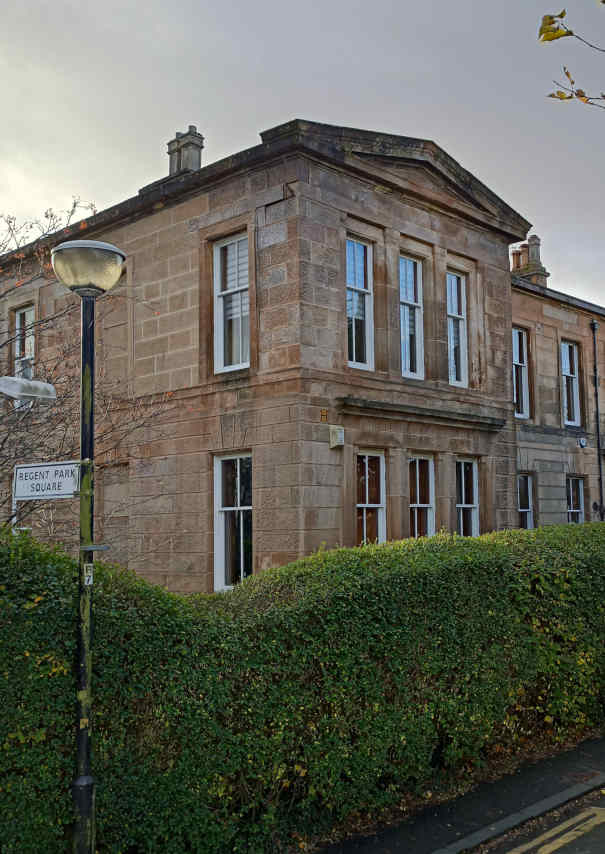







April 8, 2024 at 9:24 am
Major & Hon.Lt Colonel William Mactear, 3rd Lanarkshire Rifle Volunteer Corps
I am a collector of named Volunteer Decorations, and have recently added William Mactear’s Volunteer Decoration to my collection. Being a genealogist, with a background in social & historical geography, I like to place those recipients whose VDs of which I am a custodian, into their social & historical environment.
Your website and research on the MacTear brothers has helped significantly. I am looking to add the volunteer angle and would like to see if I can explore William’s contribution to the A & W Mactear business.